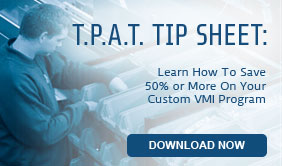 When global industrial manufacturers start thinking about class “C” parts requirements, minds instantly go to unit cost. When using millions of fasteners spread between regional manufacturing centers, each responsible for with managing unit costs, production-line efficiencies and inventory costs, cost has to be right, and uninterrupted supply can’t ever be an afterthought.
When global industrial manufacturers start thinking about class “C” parts requirements, minds instantly go to unit cost. When using millions of fasteners spread between regional manufacturing centers, each responsible for with managing unit costs, production-line efficiencies and inventory costs, cost has to be right, and uninterrupted supply can’t ever be an afterthought.
Sourcing “C” class parts from low-cost providers inherently creates challenges with guaranteeing availability and quality. Without meeting quality expectations, low-cost supply ends up meaning nothing.
We would argue that the only way quality can get the attention it deserves is through a structured, rigorous, and formally defined approach to supplier qualification, selection, and ongoing development, no matter where the supplier is located. Since that’s something Supply Technologies does every day, we feel qualified to offer advice and share what we’ve learned to ensure that whether you’re building a supplier management program yourself, or hiring a third-party supply chain partner, you have the right approach to succeed.
Qualification & Selection
We can’t emphasize this enough: Feet on the ground are critical. Whether you’re doing it yourself or working with a partner, having sourcing and supplier quality engineers’ knowledge of suppliers’ capabilities and strengths, along with their limitations, is essential.
The supplier landscape is always changing, so potential suppliers must be regularly identified, especially when it comes to new products and regions where customers are expanding. That means you need a process for identifying, evaluating, and qualifying suppliers. That process should start with an in-depth assessment of suppliers’ capabilities, locations, operations, management, and quality; followed by on-site audits to get a first-hand look at facilities, products, and quality management processes. Once the supplier is qualified, parts that are then sourced from the supplier need to be proven and verified through a rigorous assessment of first samples to all applicable specifications. To minimize time spent going back and forth over different time zones, this activity should occur in the region of the supplier. This can often be a challenge for companies attempting to do it by themselves from a location half way around the world.
Every supplier should be expected to meet rigorous performance criteria to guarantee high product and service standards, and ensure that the supply chain is never compromised by unexpected need or challenge.
Development
Ongoing evaluation of every supplier in the supply chain is a must to ensure each continues to provide ongoing product and process improvements. That evaluation should include:
- An ongoing audit plan for assessing continuous improvement
- Face-to-face interaction with suppliers to review performance and to send a clear message that you focused on quality
- Ongoing performance measurement includes ample on-time delivery, sample submission acceptance, overall quality performance, with an objective of performance exceeding industry standards
Many global manufacturers determine that their greatest competencies reside in their ability to design, develop, and launch best-in-class, breakthrough products, manufacturing them efficiently to quality levels that exceed customer expectations. At the same time, they conclude that managing a supply chain that may include a global network of suppliers producing a plethora of ”C”- class components is something that dilutes their core focus. That’s where Supply Technologies comes in.
If, as a manufacturer, you start to get a headache at the thought of managing a vendor qualification and evaluation program for a global network of class “C” part suppliers, we should talk. Give your company the power to focus on what it does best, and let Supply Technologies do what we do best.



